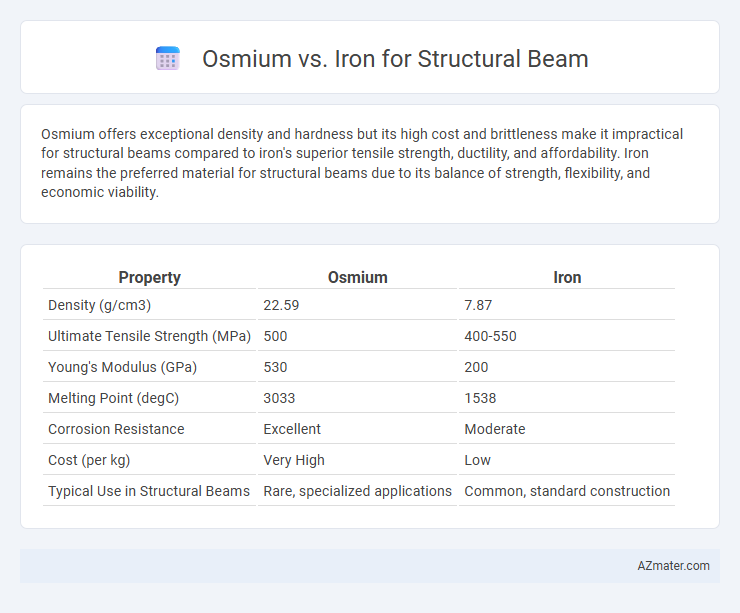Osmium offers exceptional density and hardness but its high cost and brittleness make it impractical for structural beams compared to iron's superior tensile strength, ductility, and affordability. Iron remains the preferred material for structural beams due to its balance of strength, flexibility, and economic viability.
Table of Comparison
| Property | Osmium | Iron |
|---|---|---|
| Density (g/cm3) | 22.59 | 7.87 |
| Ultimate Tensile Strength (MPa) | 500 | 400-550 |
| Young's Modulus (GPa) | 530 | 200 |
| Melting Point (degC) | 3033 | 1538 |
| Corrosion Resistance | Excellent | Moderate |
| Cost (per kg) | Very High | Low |
| Typical Use in Structural Beams | Rare, specialized applications | Common, standard construction |
Introduction to Structural Beam Materials
Osmium and iron differ significantly in their application as structural beam materials due to their physical properties and availability. Osmium, known for its exceptional density and hardness, is impractical for structural beams because of its brittleness and high cost, whereas iron, with its good tensile strength and ductility, forms the basis of steel alloys widely used in construction. Iron's balance of strength, workability, and affordability makes it the preferred material for structural beams in buildings and infrastructure projects.
Overview: Osmium and Iron Properties
Osmium is one of the densest naturally occurring elements with a density of approximately 22.59 g/cm3, offering exceptional hardness and corrosion resistance, but its brittleness limits its structural applications. Iron, with a density around 7.87 g/cm3, is widely used in construction due to its toughness, ductility, and ability to form alloys like steel, which provide a balance of strength and flexibility. The stark contrast in mechanical properties and cost places iron as the preferred material for structural beams despite osmium's superior density and hardness.
Strength and Load-Bearing Capacities
Osmium exhibits exceptional strength and density, making it one of the strongest materials known, but its extreme weight and rarity limit its practicality for structural beams. Iron, particularly in steel alloys, offers a balanced combination of high tensile strength, load-bearing capacity, and cost-effectiveness, making it the preferred choice for construction. While osmium's superior hardness could theoretically enhance load-bearing performance, iron's ductility and availability make it more suitable for structural applications.
Density and Weight Considerations
Osmium has an exceptionally high density of approximately 22.59 g/cm3, making it one of the densest elements, while iron's density is significantly lower at about 7.87 g/cm3. This density difference means osmium structural beams would be much heavier and less practical for most applications where weight reduction is critical. Iron's lower density and sufficient strength offer a better balance of weight and structural support for construction and engineering projects.
Corrosion Resistance and Durability
Osmium offers superior corrosion resistance compared to iron, exhibiting remarkable resistance to oxidation and chemical wear in harsh environments, making it ideal for applications requiring long-term durability. Iron, while cost-effective and widely used in structural beams, is prone to rust and corrosion unless treated with protective coatings, which can degrade over time. The exceptional durability of osmium ensures minimal maintenance and longevity, though its scarcity and expense limit its practical use in large-scale structural applications compared to iron.
Cost Comparison: Osmium vs Iron
Osmium is significantly more expensive than iron, with prices reaching over $40,000 per kilogram compared to iron's average cost of less than $0.10 per kilogram, making osmium economically unfeasible for structural beams in most construction projects. The high density and rarity of osmium contribute to its steep price, whereas iron's abundant availability and low production costs keep it affordable for widespread use. Cost-effectiveness remains the primary reason iron dominates structural applications despite osmium's superior hardness and strength.
Availability and Sourcing Challenges
Osmium, one of the densest and rarest elements on Earth, presents significant availability and sourcing challenges compared to iron, which is abundant and widely distributed in the Earth's crust. Extracting osmium requires complex refining processes from platinum ores, making it prohibitively expensive and unsuitable for large-scale structural beam production. In contrast, iron benefits from well-established mining infrastructure and supply chains, ensuring consistent availability and cost-effectiveness for construction applications.
Environmental Impact and Sustainability
Osmium, while extremely dense and durable, has a significantly higher environmental impact due to its rarity and energy-intensive extraction process compared to iron, which is abundant and more widely recycled in construction. Iron's recyclability and lower carbon footprint make it a more sustainable choice for structural beams, supporting circular economy principles. The environmental costs of mining and processing osmium often outweigh its material benefits in large-scale structural applications.
Suitability for Construction Applications
Osmium, despite its exceptional density and hardness, is impractical for structural beam applications due to its brittleness and high cost. Iron, especially in its alloyed form as steel, offers superior tensile strength, ductility, and cost-effectiveness, making it the preferred material for construction beams. Steel's versatility and proven performance in load-bearing structures ensure its widespread suitability over rare metals like osmium in construction engineering.
Conclusion: Best Choice for Structural Beams
Osmium, despite its exceptional density and hardness, is impractical for structural beams due to its brittleness, extreme cost, and limited availability compared to iron. Iron and its alloys, such as steel, offer superior strength-to-weight ratios, durability, cost-efficiency, and ease of fabrication, making them the preferred materials for structural applications. Therefore, iron-based materials remain the best choice for structural beams in construction and engineering projects.

Infographic: Osmium vs Iron for Structural Beam
 azmater.com
azmater.com